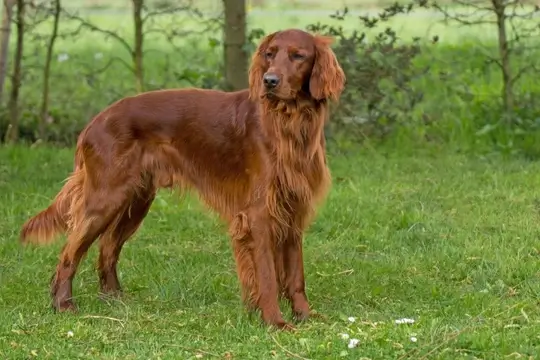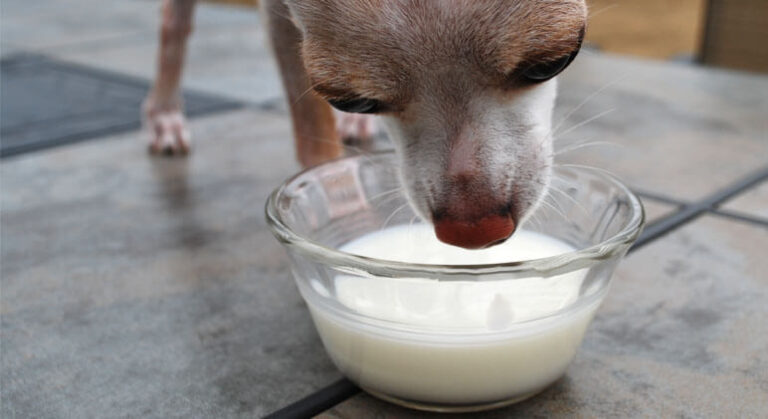Irish Setter Dog Breed | Description, Temperament, Lifespan, & Facts
The Irish Setter is a breed known for its stunning red coat, playful personality, and boundless energy. Originally bred for hunting, this breed has won the hearts of dog lovers worldwide due to its affectionate nature and striking appearance. If you’re considering bringing an Irish Setter into your home, it’s essential to understand their history, characteristics, and care requirements to ensure a happy and healthy life together.
Contents
- 1 A Brief History of the Irish Setter
- 2 Why Choose an Irish Setter?
- 3 Physical Characteristics of the Irish Setter
- 4 Size and Weight
- 5 Coat Color and Grooming Needs
- 6 Distinctive Features
- 7 Temperament and Personality Traits
- 8 General Disposition
- 9 Interaction with Children and Other Pets
- 10 Training and Socialization
- 11 Lifespan and Health Considerations
- 12 Common Health Issues
- 13 Preventative Care and Regular Check-ups
- 14 Average Lifespan
- 15 Exercise and Activity Requirements
- 16 Daily Exercise Needs
- 17 Suitable Activities and Sports
- 18 Mental Stimulation
- 19 Nutrition and Feeding Guidelines
- 20 Recommended Diet
- 21 Feeding Schedule
- 22 Special Dietary Considerations
- 23 Grooming and Maintenance
- 24 Grooming Routine
- 25 Bathing and Coat Care
- 26 Nail, Teeth, and Ear Care
- 27 Living with an Irish Setter
- 28 Suitable Living Environments
- 29 Travel and Adventures
- 30 Fun Facts About Irish Setters
- 31 Famous Irish Setters in History and Pop Culture
- 32 Unique Traits and Quirks
- 33 Choosing an Irish Setter Puppy
- 34 Selecting a Reputable Breeder
- 35 What to Look for in a Healthy Puppy
A Brief History of the Irish Setter
The Irish Setter’s origins can be traced back to Ireland in the 18th century. Initially, they were used as hunting dogs, specializing in setting or locating game birds for hunters. Over time, selective breeding refined their appearance and temperament, leading to the elegant and graceful breed we know today. Irish Setters gained popularity not only for their hunting skills but also for their beauty, becoming a favorite in dog shows and as family companions.
Why Choose an Irish Setter?
Choosing an Irish Setter means welcoming a lively, loving, and intelligent dog into your family. They are known for their loyalty and friendliness, making them excellent companions for active individuals or families with children. Their energy and enthusiasm for life require an owner who can provide ample exercise and mental stimulation.
Physical Characteristics of the Irish Setter

Irish Setters are medium to large-sized dogs, characterized by their sleek, athletic build and beautiful mahogany coat. Their physical attributes contribute to their hunting prowess and add to their overall charm.
Size and Weight
Typically, male Irish Setters stand about 27 inches tall at the shoulder, while females are slightly smaller at around 25 inches. Their weight ranges from 60 to 70 pounds, making them robust and sturdy without being overly large.
Coat Color and Grooming Needs
The hallmark of the Irish Setter is its luxurious, silky coat, which ranges in color from chestnut to mahogany. Regular grooming is essential to maintain their coat’s beauty and prevent matting. Brushing several times a week and occasional baths will keep their fur shiny and healthy.
Distinctive Features
Irish Setters have a distinctive, elegant appearance with a long, lean head, expressive dark eyes, and a deep chest. Their ears are set low and hang close to their heads, adding to their refined look. Their tails are long and feathered, carried horizontally when the dog is excited or alert.
Temperament and Personality Traits
Irish Setters are renowned for their friendly and outgoing nature. They thrive on human interaction and are known for their playful and affectionate demeanor.
General Disposition
These dogs are often described as exuberant and high-spirited. They are intelligent and eager to please, making them highly trainable, although they can sometimes be a bit stubborn. Their friendly nature extends to everyone they meet, making them poor guard dogs but excellent companions.
Interaction with Children and Other Pets
Irish Setters are known for their gentle and playful interaction with children, making them great family pets. They generally get along well with other dogs and pets, especially if they are socialized from a young age. Their high energy levels mean they enjoy active play and thrive in a household that can match their enthusiasm.
Training and Socialization
Early training and socialization are crucial for Irish settlers. Positive reinforcement techniques work best, as these dogs respond well to praise and treats. Consistent training helps manage their energy and ensures they grow into well-behaved adults.
Lifespan and Health Considerations
Irish Setters are generally healthy dogs, but like all breeds, they are prone to certain health conditions. Understanding these potential issues and providing regular veterinary care can help ensure a long, healthy life.
Common Health Issues

Some common health problems in Irish settlers include hip dysplasia, progressive retinal atrophy (PRA), and hypothyroidism. Regular check-ups and screenings can help detect these conditions early, allowing for prompt treatment.
Preventative Care and Regular Check-ups
Regular veterinary visits are essential to keep your Irish Setter healthy. Routine vaccinations, dental care, and preventive treatments for parasites are important aspects of their overall care. Maintaining a healthy diet and regular exercise also play a significant role in their well-being.
Average Lifespan
The average lifespan of an Irish Setter is around 12 to 15 years. With proper care, nutrition, and regular veterinary visits, many Irish Settlers enjoy a long and active life.
Exercise and Activity Requirements
Irish Setters are high-energy dogs that require plenty of exercise to stay happy and healthy. Their history as hunting dogs means they have a lot of stamina and enjoy activities that challenge both their minds and bodies.
Daily Exercise Needs
Irish Setters need at least an hour of vigorous exercise each day. This can include long walks, runs, or play sessions in a secure area. They also enjoy activities that engage their hunting instincts, such as fetch or agility training.
Suitable Activities and Sports
These dogs excel in canine sports like agility, obedience, and rally. Participating in these activities can provide the physical and mental stimulation they need. Irish Setters also make excellent jogging or hiking companions.
Mental Stimulation
In addition to physical exercise, Irish settlers need mental stimulation to prevent boredom and destructive behavior. Puzzle toys, training sessions, and interactive games can help keep their minds sharp.
Nutrition and Feeding Guidelines
Proper nutrition is crucial for the health and longevity of your Irish Setter. A balanced diet tailored to their age, weight, and activity level will help maintain their energy and overall well-being.
Recommended Diet
Irish Setters thrive on high-quality commercial dog food that meets their nutritional needs. Look for formulas that list meat as the first ingredient, and avoid fillers like corn and soy. Some owners prefer feeding a raw or homemade diet, but it’s important to consult with a veterinarian to ensure it meets all nutritional requirements.
Feeding Schedule
Divide their daily food intake into two meals to prevent bloating, a condition to which large breeds are susceptible. Consistent feeding times can also help regulate their digestive system and to avoid overeating.
Special Dietary Considerations
Some Irish Settlers may have food sensitivities or allergies. If you notice symptoms like itching, gastrointestinal issues, or ear infections, consult your vet to determine if a special diet is necessary.
Grooming and Maintenance
Regular grooming is essential to keep your Irish Setter looking their best and to maintain their overall health. Their beautiful coat requires dedicated care to prevent matting and tangling.
Grooming Routine
Brush your Irish Setter’s coat at least three times a week to remove loose hair and prevent mats. Pay special attention to the areas behind the ears, under the legs, and around the tail, where tangles are more likely to occur.
Bathing and Coat Care
Bathe your Irish Setter every 4 to 6 weeks or as needed, using a gentle dog shampoo. Regular baths help keep their coat clean and healthy. After bathing, ensure their coat is thoroughly dried to prevent skin issues.
Nail, Teeth, and Ear Care
Trim your dog’s nails regularly to prevent overgrowth and discomfort. Brush their teeth several times a week to prevent dental disease. Check their ears weekly for signs of infection, such as redness, odor, or excessive wax, and clean them as needed.
Living with an Irish Setter
Irish Setters make wonderful companions, but they do require a specific living environment that caters to their needs. Understanding what to expect can help you provide a happy and fulfilling life for your dog.
Suitable Living Environments
Irish Setters are best suited for homes with plenty of space to run and play. They are not well-suited for apartment living unless they receive ample exercise outside. A house with a fenced yard is ideal to allow them to burn off their energy safely.
Travel and Adventures
Irish Setters love adventures and are great travel companions. Whether it’s a hike in the mountains or a trip to the beach, they enjoy exploring new places. Ensure your dog is well-trained and comfortable in various environments before embarking on trips together.
Common Behavioral Issues and Solutions
While generally well-behaved, Irish Setters can develop behavioral issues if not properly trained and exercised. Common problems include excessive barking, digging, and chewing. Address these issues with consistent training, adequate exercise, and providing appropriate outlets for their energy.
Fun Facts About Irish Setters
Irish Setters are more than just beautiful dogs; they have a rich history and unique traits that make them fascinating companions.
Famous Irish Setters in History and Pop Culture
Irish Setters have been featured in various movies, TV shows, and books. One of the most famous Irish Setters is Big Red, the star of Jim Kjelgaard’s novel series. Their striking appearance and friendly nature make them popular in the media.
Unique Traits and Quirks
Irish Setters are known for their “birdy” behavior, stemming from their hunting heritage. They often display pointing behavior, even if they have never been trained to hunt. Their enthusiastic greeting style, usually called the “Irish Setter Dance,” involves joyful leaps and spins.
Choosing an Irish Setter Puppy
Bringing an Irish Setter puppy into your home is a big decision. It’s important to choose a healthy, well-bred puppy from a reputable source to ensure a positive experience.
Selecting a Reputable Breeder
Choose a breeder who prioritizes health, temperament, and breed standards. A good breeder will provide health clearances for the puppy’s parents and allow you to visit their facility to meet the puppies and their mother.
What to Look for in a Healthy Puppy
A healthy Irish Setter puppy should be lively, with clear eyes, a clean coat, and no signs of illness. They should be curious and playful, displaying typical puppy behavior. Avoid puppies that seem lethargic or overly shy.
Conclusion
The Irish Setter is a remarkable breed known for its stunning red coat, boundless energy, and affectionate nature. Their rich history as hunting dogs has endowed them with intelligence, athleticism, and a spirited personality that brings joy to any household. While they require significant exercise, grooming, and mental stimulation, the rewards are immense—loyalty, love, and endless fun.
- Golden Retriever Pros and Cons: What Every Pet Parent Should Know - 15 September 2025
- Cane Corso Dog Breed: Health, Care, and Lifespan - 14 September 2025
- Catahoula Leopard Dogs: Description, Temperament, Lifespan, & Facts - 21 July 2025







